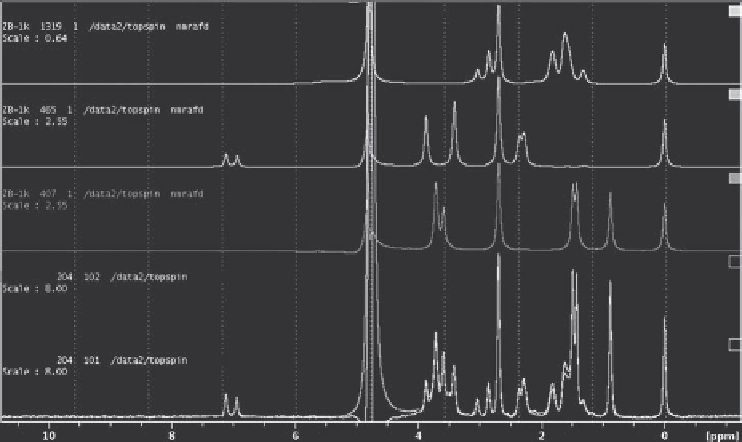Chemistry Reference
In-Depth Information
(b)
Figure 6.1
(
Continued
)
.
(a) the biochemical function of the protein and (b) the constraints of NMR. Specifically, the
major concern related to NMR is susceptibility mismatch between the solid support and the
surrounding aqueous environment. Meyer's group had originally demonstrated ligand bind-
ing to targets immobilized on glass beads.
[
17
]
However, the susceptibility mismatch was so
severe in this case that magic angle spinningNMRwas necessary to average out the inhomo-
geneity. Clearly, this arrangement would not be compatible with flow-injection NMR, so
we sought a solid support which would not bind the compounds, would provide high
capacity to immobilize proteins and would minimize susceptibility differences. Sepharose-
based affinity resins turned out to be very useful in that they are very good matches for
this list of requirements. In contrast to glass beads, Sepharose beads can be more readily
described as a three-dimensional, biocompatible mesh which is highly hydrated, yet suffi-
ciently rigid to maintain good flow characteristics even after 300 applications of compound
mixes. The susceptibility mismatch is minimal such that under our current screening setup,
using the dual-cell sample holder made from KelF, we routinely obtain a linewidth of
about 12 Hz. However, the nature of the immobilization chemistry of the Sepharose bead
also appears to play a role in the linewidth observed for the compounds, as can be seen
in Figure 6.2.
A wide range of immobilization chemistries are commercially available in conjunction
with Sepharose beads. We have investigated a limited subset of these possibilities which
include: direct, nonoriented immobilization via Schiff's base chemistry, oriented nonco-
valent immobilization via immobilized metal affinity chromatography resins and oriented
noncovalent immobilization via biotin-streptavidin binding. At present we favor direct,
covalent attachment of proteins via primary amines since it is highly efficient (typically
better than 85% yield), minimizes leaching and provides the best NMR results (Figure 6.2).

